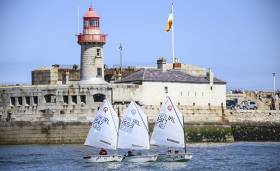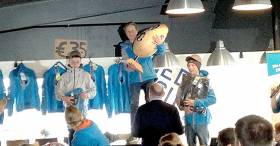Displaying items by tag: Optimist
The Cois Sionna Credit Union Connachts are open for entries now. The event takes place in Foynes Yacht Club on June 11th and 12th.
Regular Entry Fee is €60 and the closing date is Friday 27th May. (Late Entry Fee: €120 & final closing date is Wednesday 1st June)
A combined fleet of 148 Optimist dinghies racing in Senior, Junior and Regatta fleets competed for Leinster Championships honours at the Royal St. George Yacht Club at the weekend. Senior honours in a 48–boat fleet went to 15–year–old Harry Bell of Howth Yacht Club who was four points clear of Micheal O'Suilleabhain of Kinsale Yacht Club. Third was Alfonso Moreno Perez of Royal Cork Yacht Club. Six races were sailed with one discard. In the junior fleet, 12–year–old Michael Crosbie of Royal Cork Yacht Club was the winner in the 43–boat fleet. Local sailor Jessica Riordan of the host club was the regatta winner in her 41–boat fleet.
O'Suileabhain Second in Optimist Braassemermeer Easter Regatta
Team CH Marine member Micheal O'Suileabhain from Kinsale Yacht Club finished second overall at the Optimist Braassemermeer Easter Regatta in Holland yesterday. According to the IODAI, the series was cut short with the arrival of storm 'Katie'. It meant the series was completed in nine races and the battle for the Easter regatta's giant egg was between Micheal and two Dutch sailors. Just two points separated the top three. An Irish team were competing in the 242–boat fleet drawn from 15 countries.
Foynes Yacht Club Laser Fleet Expands
It’s feast or famine with the wind these days at Foynes Yacht Club and after being blown out last weekend the possibility of getting a final days racing in the Reidy’s Centra Laser and Topper Series wasn’t looking promising as for much of the morning the River Shannon looked more like a sheet of glass than a sailing venue.
Racing was postponed until shortly after 1pm to allow the forecasted 8-10kts to build. The laser fleet continues to expand with another new junior sailor, Clara Shanahan, joining the racing today. OOD Vincent McCormack unusually brought the fleet west of Foynes Island which paid off as a nice breeze filled in albeit from the north and not SE as forecast and the race team managed to get in two windward-leeward races to conclude the series. The Junior Category was won by Dylan Reidy and the Senior Category by Cathal McMahon. Dinghy racing will continue next weekend with the March Laser and Topper Series starting next Sunday, 6th March.
Earlier this month four of Foynes newest and youngest boat owners took part in the week long optimist training camp in Baltimore. This is first time the club have had members taking part and the young sailors had a great week. Fresh with enthusiasm from the camp the oppie sailors, the fleet now up to six, took to the water to try out their newly acquired knowledge and skills. The future of the club is in good hands with these young sailors who fought off the cold with brave smiles for three very competitive races.
While winter projects continue in the yard the clubhouse is also getting plenty of use. This weekend the ISA had organised a Race Officer Level One Course at the Foynes venue. The course was given by National Race Officer Geoff O’Donoghue from Lough Derg Yacht Club and had a huge attendance with over 30 members from seven clubs along the west coast and the lakes taking part.
Next Saturday, 5th March, the Irish Cruiser Racing Association annual conference takes place in Limerick. The club are very proud to see one of their own members, Simon McGibney, take over the role of ICRA Commodore and would like to wish him every success in his tenure. The conference is on in the Castletroy Park Hotel from 10am and all cruiser sailors are welcome.
Baltimore Drone Footage Shows Off IODAI Optimist Training Camp
It may have had a breezy conclusion but last Monday and Tuesday were amazing days in Baltimore for the IODAI Optimist training week with sunshine, light winds and as this drone footage shows beautiful West Cork boating scenery.
West Cork Awakes With Mid–Term Dinghy Sailing
West Cork is fully afloat this week with junior sailors from all over Ireland including some from Wales writes Claire Bateman.
With the schools on mid term break it was once again time for the annual trek west for the sailors and their families. We watched the trail of vehicles heading westward, as usual packed to the roof, some trailing boats and some with them on roofs. The vehicles always seem to be packed with numerous excited children accompanying their parents not to mention the wide variety of breeds and numbers of mutts accompanying their families.
In Schull, some thirty Lasers were attending a training session, with thirteen 420s and seventeen Toppers all adding up to make a colourful scene.
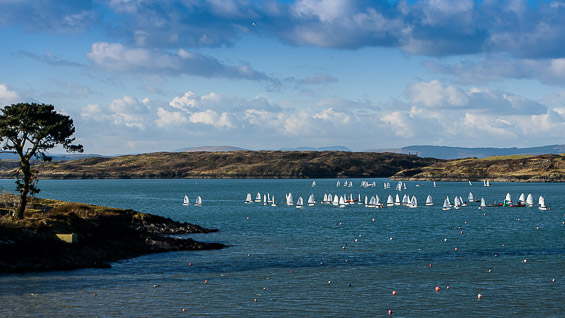

In nearby Baltimore, some one hundred and forty Optimists including the Senior, Junior and Regatta fleets from nineteen clubs all over Ireland and some from Wales, were being processed and given their various coloured ribbons to indicate their fleets and Coaches before splitting into briefing groups . The more experienced were putting to sea following their briefing. Meanwhile, the Regatta Fleet were being entertained ashore and finally the more energetic parents were taking the aforementioned mutts for brisk walks to the famous Beacon with the more exhausted parents seeking some comforting food in the well renowned local hostelry.
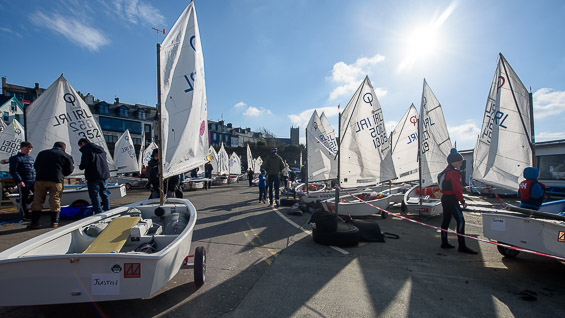
Surely Spring is now well sprung and we can hopefully look forward to a good Junior season for 2016.


Ireland’s Boats & People – How Do We Get Them Together?
The recently-published ISA Survey of Club Racing commissioned and supervised by Board Member Jack Roy has started the process of putting together a realistic picture of how we sail and go afloat for recreation, and it was analysed on publication here in Afloat.ie.
It’s logical to have made the beginning with club racing, as racing provides its own narrative and a straightforward set of entry numbers and results. But it will become more complex as the national authority tries to provide realistic figures for day sailing’s less competitive aspects. And of course, once we enter the world of cruising as defined by sailing and boating projects which include passage making, both coastal and offshore, together with overnight on-board stops, then it can become much more difficult to get meaningful data.
Yet with the ISA’s Cruising Conference for February 20th already booked out within a few days of being announced on Afloat.ie, clearly that is an area in search of services and support, a section of sailing which is difficult to quantify yet obviously of strong interest to a significant number of boat enthusiasts. W M Nixon takes a look at how the complexity of our sport’s many specialities makes it difficult to provide a clearcut picture for possible recruits to sailing.
Where would we be without the International Optimist Dinghy? The little solo-sailing boxes and their attendant support teams of mum and dad and the dog and the old 4X4 or station wagon or people carrier or whatever may seem to take up an awful lot of space and time, and all just so that one little person can go sailing.
But at least that one little person does go sailing. The ISA figures are brutally straightforward. In terms of genuine turnouts afloat at clubs throughout Ireland, in boat numbers the active Optimists are exceeded only by the Lasers, and this is arguably because Lasers aren’t age-limited, whereas the Optimists most definitely are.

Optimist airborne. This is Ireland's second most popular class
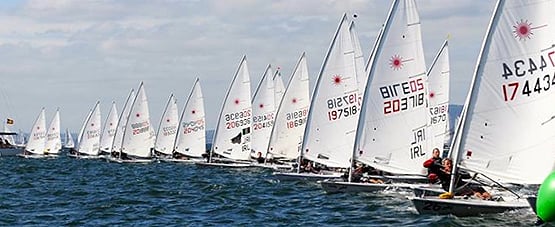
Ireland’s most popular dinghy class, the Laser is seen here at the Zhik Irish Nationals at Ballyholme
So we give a qualified cheer for the success of these two little boats. But it’s qualified because they’re single-handers which fail to provide any crew-relating sailing skills. Leading sailing figures as diverse as Des McWilliam of Crosshaven and Norman Lee of Greystones have been eloquent in promoting the notion that we should be doing more – much more – to encourage two-handed boats, and if we can persuade people into three-handed boats, well, so much the better.
Certainly that’s one of the reasons why our header photo says so much. A lone sailor in an Optimist or Laser promotes too much of a solitary, even an isolated image. And a two-handed boat like the GP 14, whose strong fleet figures in the ISA survey show the class’s vigour, is arguably just an act for a dynamic duo – it’s Strictly Come Dancing goes sailing…..
But getting three together to race a characterful boat like the National 18 with style – now that’s something special, that really is a superb combination of people skills interacting with sailing talent. And it’s a joy to behold. Yet anyone can see that for a complete beginner to sailing, this extraordinary silhouette of Tommy Dwyer’s National 18 against the November sky above the Hill of Howth will have an otherworldly air about it – “That’s not for me” is as likely a response as “Let’s have a go at that”.
Even those of us who have been in sailing for longer than we care to remember find the image decidedly thought-provoking, for we have some idea of what has been involved in creating the circumstances for this seemingly effortless balancing act, this lighter-than-air effect in the unlikely setting of a November afternoon.
Over the past year or so we have been recounting in Afloat,ie how the Cork Harbour National 18 Class, with very tangible backing from the Royal Cork Yacht Club, have been in the forefront of the development of the new ground-breaking Phil Morrison take on the long-established National 18, which is a developmental class which from time to time takes a leap in hull design, and moves forward in order to keep the spirit alive.
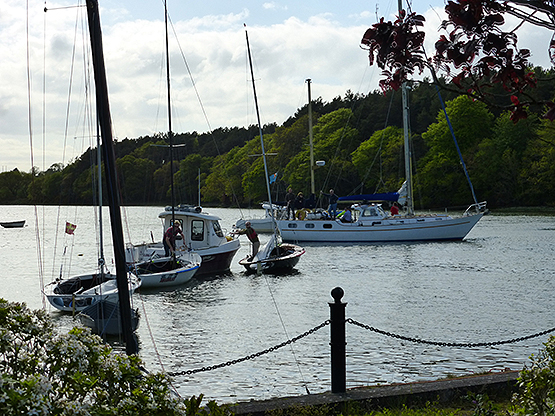
The National 18s are part of the fabric of Cork Harbour sailing. Before the new Morrison boats arrived in July, the old fleet were seen here in May 2015 after their annual race to Ballinacurra in northeast Cork Harbour in company with the Dwyer brothers’ cruising ketch. Photo: W M Nixon
Acceptance of this is something which seems to be bred into Cork’s National 18 enthusiasts, many of whom have the advantage of being firmly of the opinion that a proper dinghy needs three people to sail it. But the social matrix which has built up around Cork Harbour over many decades with this concept at its heart is not something which will necessarily travel easily to other areas, and although the six boats of the National 18 flotilla which visited Howth for the Open Day got a great reception and gave many people from other classes a marvellous time afloat, it’s probable that the very different mood around sailing in Dublin means that something so technically and socially challenging as a three man dinghy is a step too far.
Sailing in the greater Dublin area seems to exist within a framework of independent balloons. While there are those who will happily move from one boat type to another and cheerfully spread their talents and enjoyment about, by contrast there’s the Dublin Bay Sailing Club Thursday Evening Phenomenon.
Thursday is when the DBSC cruiser classes go out to race. And there’s an entire cohort of people, mostly folk who work in offices in the city, who on a Thursday evening go straight to Dun Laoghaire, get aboard a pontoon-based cruiser owned by someone else, go out and race in some very specific crewing job, then come back in and have supper in club or pub with their shipmates, and then that’s it until next Thursday. Just one evening each summer mid-week is their entire sailing programme. Weekends are for something else. And as for the hassle and mixed joys of boat ownership and maintenance, that’s not their department at all.
It’s a very metropolitan, very citified yet specialized way of doing things, and Dublin is one of the very few cities whose location facilitates it. It will be fascinating to measure it, for Dublin’s way of sailing is steeped in history and tradition. But for now it’s refreshing to look at a place which has had a sailing tradition in times past, but somehow lost it, yet it’s coming back again, and one of the good news stories towards the end of 2015 is that the new Youghal Sailing Club has been accepted into the ISA fold.
Youghal at present is a difficult place for sailing, as the tidal power of the mighty Munster Blackwater sweeps straight through the estuary and along the old town’s waterfront, and the creation of any meaningful modern facilities will have the immediate difficulty of silting by incredibly adhesive black mud.

With the sun out, and the tide in, Youghal looks to be an ideal location for the easy installation of a marina….....Photo: W M Nixon
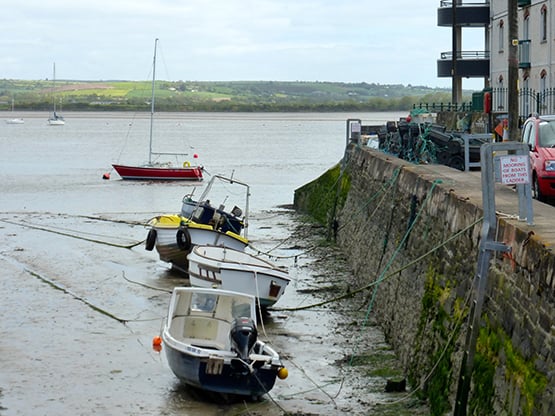
….but with the sun in and the tide out, the mud problem is revealed. Photo: W M Nixon
Thus, as dedicated Afloat.ie readers will have recently observed, no sooner had one group announced that a marina in Youghal was on the way than another longer-established group quietly suppressed the story, as they’re well aware of the engineering and dredging difficulties involved, and premature announcements will only slow any project in the long run.
In the fullness of time, a marina at Youghal will be a godsend for any cruiser plugging along the south coast. It’s not always the easiest coast in the world to make a passage along, sometimes it can seem an awfully long way to Cork from Dunmore East or Kilmore Quay even if you do make stopovers at Dungarvan or Helvick, and there are times when the hardiest seafarer is glad enough to get his boat secured to a good big pontoon.
But that’s for the future. Meantime, the locally-based keelboats are using either the restless anchorage off the town, or the more serene pool across the estuary at Ferry Point on the east shore, while the new club’s flotilla of GP 14s are stored in spare warehouse space during non-sailing time, and when they do go sailing it turns out their clubhouse is a moveable feast - it’s a caravan which can be towed to a choice of sailing locations.
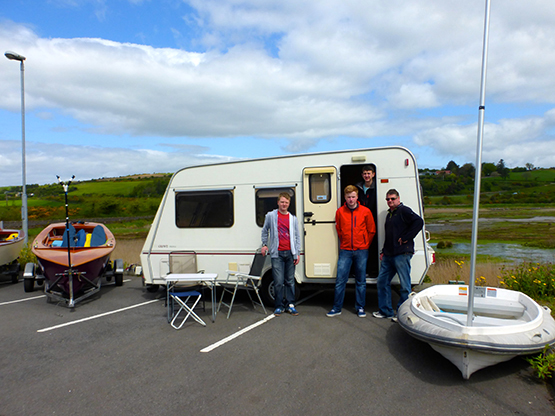
A moveable feast. Members of the newly-affiliated Youghal Sailing Club with their caravan HQ, Adrian Lee in doorway. Photo: W M Nixon
On the national stage, it is young Youghal GP 14 sailor Adrian Lee who has been among those flying the club’s flag, and there’s hope in the air. When we were there in May on a fine day that promised a summer which never arrived, we couldn’t help but think that when they do get their facilities and maybe even a clubhouse, they’ll look back to the days of the caravan and ad hoc racing arrangements with sweet nostalgia. For sometimes, it’s much better to be travelling than it is to arrive.
But for the rest of us, the message from Youghal is simple. The sea is for sailing. Use it or lose it. By all means get proper people surveys done which indicate the way numbers are shaping up and things are going. But really, if you want to persuade people to go sailing, the best way is by example, getting afloat as much as possible yourself. And maybe then you’ll find the time to welcome aboard newcomers too.

Reviving Youghal sailing – on race days, the club’s caravan is simply towed down to the pier and the races are started from there. Photo: W M Nixon
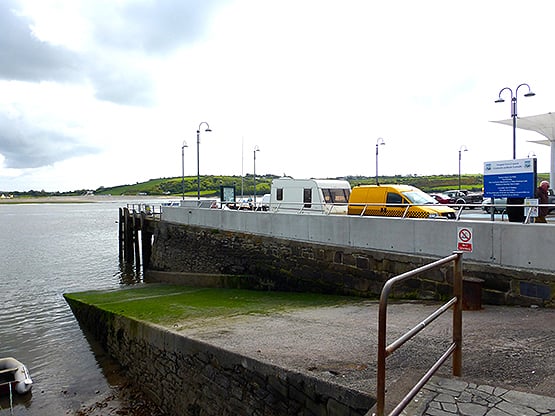
Youghal’s massive public slip provides launching for the YSC sailing dinghies, but during 2015 the boats had to be stored at the other end of town when not in use. Photo: W M Nixon
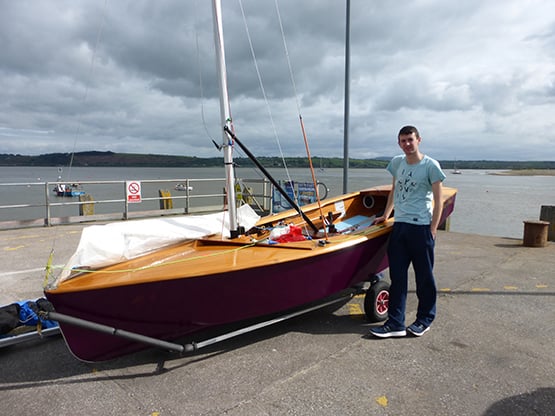
The pace-setter. Adrian Lee of Youghal SC with his Duffin-built GP14. Photo: W M Nixon
Click to download: ISA Survey of Club Racing
Optimists Prepare for Baltimore Training Week 2016
The Irish Optimist Dinghy Association of Ireland (IODAI) will hold its spring training week at Baltimore sailing Club in West Cork over the February 2016 Mid-term break. This is Ireland’s largest sailing camp and generally caters for up to 160 sailors from 8 – 15 yrs old.
The village of Baltimore will be effectively taken over by approximately 160 keen sailors and their families for the week. A team of International coaches from Greece, & Poland are joined by top Irish coaches to provide training for sailors of all competencies, from those who have only recently started to sail to those who are competing internationally.
The Baltimore event is considered to be one of the top International clinics in Europe. It is very much a family-oriented event, with a programme of activities for children too young to sail, and events also organised for adults, such as the ‘How to Rig an Oppi’ class for novice parents! Schull & Fitbones
provides activities for those 5 years and upwards who are not yet sailing, they do Baltimore Treasure Hunt and Playground games, Sherkin Island trip and an Adventure Challenge in Lough Hyne Woods .
The event is organised by IODAI which is comprised of volunteers, which are the parents of sailors. It takes 25 – 30 volunteers per day to run the event efficiently and the overall event is managed by Mandy Kelly and assisted by Sara Lacy both parents of sailors.
Evening activities are also on offer, including the ever-popular ‘a cinema night, disco night and of course the cake competition on the last day of sailing. In addition the week finishes off with a one day regatta which helps sailors consolidate all they have learnt during the week & to put it into practice.
An IODAI forum takes place during the Baltimore week where all parents are invited to express their views or seek information on the running of the Optimist class.
Busy Autumn Sailing Scene in Dun Laoghaire
Is Dun Laoghaire Harbour a busier dinghy sailing venue on Autumn Sundays than it is in Summer? Certainly if yesterday's activity at the National Yacht Club, Royal St. George YC, Royal Irish, Irish National Sailing School and DMYC is anything to go by.
While Anthony O'Leary was winning the All Ireland sailing championships just off the harbour mouth there was no less than six other fleets racing or race training in and around the east coast port. Just as the season is meant to be tapering off Fireflies were team racing from the Royal St. George Yacht Club and Fireballs were giving 'just for fun' demo sails from the DMYC but far and away the main point of interest in the NYC was for the Jelly Bean Junior Regatta (pictured above) that had a variety of fleets racing across the harbour.
In addition Laser 4.7s were training in Scotsman's Bay and a number of foiling Moths came out to play when the breeze puffed up to 15 knots yesterday afternoon. A perfect breeze to give the INSS novices plenty of fun on the east bight in colourful Laser Pico dinghies.
If there was any disappointment it was that there were few – if any at Ireland's biggest sailing centre – that ventured out to spectate at a thrilling final of the All Ireland Sailing Championships but that's because Dun Laoghaire sailors were all too busy sailing themselves?
Royal Cork Optimist Sailor Takes Allianz Leinster Victory off Howth
Day two of the Optimist Leinster championship at Howth Yacht Club dawned with a lot less wind than the previous one, posing difficulties for sailors and race officers alike.
Launching was slightly delayed as the optimistic sailors waited for the wind to fill in.
The feather weights in the fleet cheered silently whereas the heavy weather sailors hoped that windguru had got it wrong and that perchance 20 knots was on the way.
Race 4 of the championship was completed in 7 knots of breeze and in the senior fleet Cathal O'Regan RCYC took a bullet followed by Jack Fahy Rsgyc. In the juniors Royal Cork took line honours with Michael Crosbie taking first followed by Harry Twomey. After this the longed for discard kicked and places reshuffled.
Race five of the championship was started for the junior fleet in 5 knots of breeze but had to be abandoned after a significant wind shift which would have resulted in an unfair race.
Once again the junior fleet started but after the wind died away the PRO made the wise decision to once again abandon as too much was at stake to risk having a floating race.
Ribs were sent out in all directions in search of the elusive wind which appeared to be playing hide and seek. Finally wind filled in and having moved the course in the direction of Portmarnock one race was completed for both senior and junior fleets. The 3pm deadline for starting a race was fast approaching and having all had a long day on the water and sailed fairly PRO Richard Kissane made the wise decision to send the fleet home.
Local sailor and overnight leader Dylan O'Grady had to concede to Cathal O'Regan for Leinster Championship honors as the cork sailor won out on count back. In the Junior Fleet Aoife Byrne was the outright winner followed by the National Yacht Clubs Conor Gorman who had improved tremendously on his position from yesterday.
The Regatta fleet once again had a great days sailing and PRO Des Flood managed to get one race in which was won by HYC's Sarah Evan's. The overall winner of the regatta fleets 4 races was John Twomey.
The top 5 winners in the Senior and Junior Fleets are listed below.
Senior Fleet
1 Cathal O'Regan Royal Cork Yacht Club
2 Dylan O'Grady Howth Yacht Club
3 Kate Darcy Royal Cork Yacht Club
4 Tom Higgins Royal St. George Yacht Club
5. Charlie Cullen National Yacht Club
Junior Fleet
1 Aoife Byrne Royal Cork Yacht Club
2 Conor Gorman. National Yacht Club
3 Rory O'Sullivan. Royal Cork Yacht Club
4 Harry Twomey Royal Cork Yacht Club
5 Leah Rickard National Yacht Club
Congratulations to the event management and hospitality teams in HYC chaired by ISA board member Robert Dix for hosting a fantastic event.
This concluded the IODAI event roundup for the season. Prizes were awarded first to the. Regatta Fleet sailors and then later the main prize giving concluded at 5 pm.
Congratulations to all the sailors who have learnt so much over the season see you all next year!



























